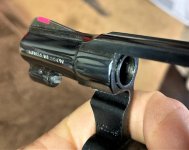ezb57
Member
Hello: How bad do forcing cones have to be before they cause or contribute to spitting? This old Model 49 of mine has always been a bit dirty shooting. The B/C gap is at .002. Not many rounds through it overall, less than 1000 for sure. Concentric machining lines are very clear on the cone. Should I clean this up? I realize if its way out of time it doesn’t matter how good the cone is. My inexpert inspection makes me think the timing is pretty good.
I don’t have a range rod or cone cutter; they aren’t easy to find for sale either. I don’t know of any sources other than Brownells. May rent them, but it doesn’t look like 4D rents range rods.
Also, what forcing cone angle does Smith use on their revolvers?
Are there advantages to the other angles used out there?
Thanks in advance.
I don’t have a range rod or cone cutter; they aren’t easy to find for sale either. I don’t know of any sources other than Brownells. May rent them, but it doesn’t look like 4D rents range rods.
Also, what forcing cone angle does Smith use on their revolvers?
Are there advantages to the other angles used out there?
Thanks in advance.






